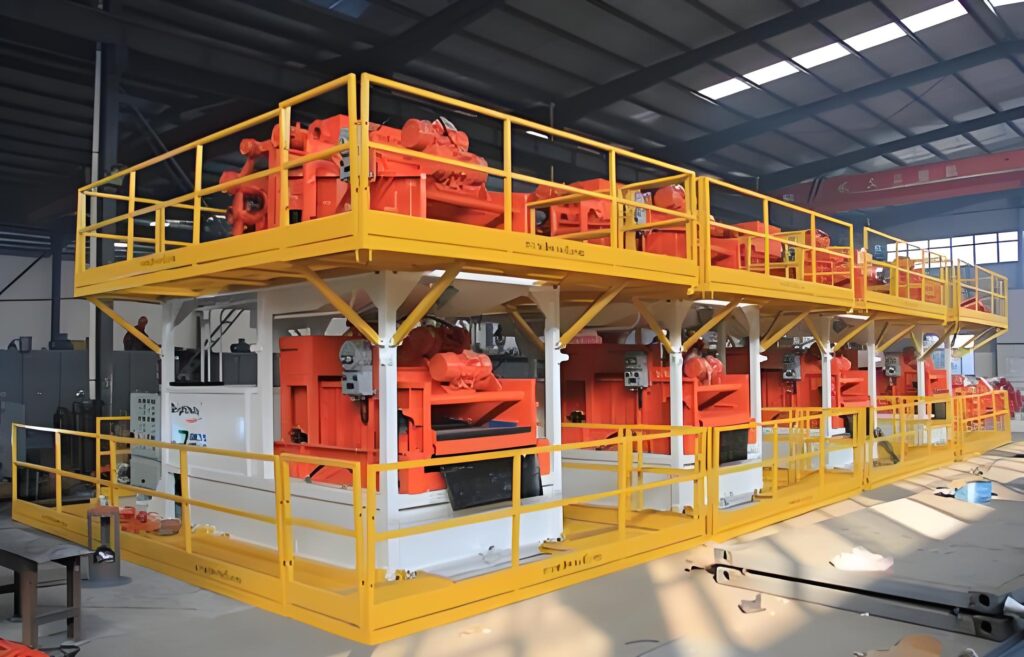A typical slurry separation system used in shield tunneling projects consists of five main units:
- Slurry Separation and Treatment Unit
- Slurry Mixing Unit
- Slurry Preparation Unit
- Slurry Transportation Unit
- Slurry Monitoring and Integrated Control Unit

1. Slurry Separation and Treatment Unit
The role of this unit is to separate solids and liquids from the slurry created by the cutterhead as it excavates clay and crushed rock. Multi-stage separation is carried out based on project requirements until the slurry can be reused.
When selecting slurry treatment equipment, two aspects must be considered:
- It must effectively separate sand and soil from the slurry while controlling slurry density.
- It must provide a processing capacity that matches the tunneling machine’s advance rate.
For secondary solid-phase separation, a high-frequency dewatering vibrating screen is typically used. This equipment performs initial screening of the slurry, efficiently removing clumps and larger particles, while also controlling the moisture content of discharged solids. Such control is especially important for meeting environmental requirements like waste minimization and non-disposal transport. For coarse particle separation, double-layer or triple-layer vibrating screens are commonly adopted.
2. Slurry Mixing Unit
The slurry mixing unit is composed of:
- Fresh slurry tank, pump, agitator, and storage tank
- CMS (Chemical Mud Solution) mixing tank, agitator, pump, and distribution valve
- Water supply equipment
The CMS mixing tank stores chemical slurry, while the fresh slurry tank stores materials such as bentonite. After mixing, the CMS chemical slurry is transferred to the fresh slurry tank for further blending, producing fresh slurry for shield tunneling operations.
3. Slurry Preparation Unit
This unit consists of:
- Adjustment tank and residual tank
- Agitators for both tanks
- Adjustment pump, residual pump, density pump, feeding pump, and water supply equipment
The adjustment tank is used to balance new and used slurry, while the residual tank stores mixed slurry. Agitators keep the slurry in motion, and a density pump monitors slurry density. Once adjusted, the prepared slurry is pumped to the shield machine’s slurry chamber.
4. Slurry Transportation Unit
The transportation unit delivers adjusted slurry from the preparation unit into the shield slurry chamber via feeding pumps and pipelines, supporting the tunneling machine’s circulation system.
Meanwhile, the excavated soil and slurry mixture is extracted from the chamber and pumped through discharge pipelines to the surface slurry treatment system for separation. This unit is primarily composed of feeding and discharge pumps, valve assemblies, pipelines, and related components, all operated through the slurry monitoring system for automated control.
5. Slurry Monitoring and Control Unit
The entire slurry separation system is managed by a slurry monitoring and control system, which runs on a PLC program. This system provides continuous data collection and real-time feedback to ensure reliable shield tunneling operations.
The monitoring module supports five operating modes:
- Bypass Mode
- Excavation Mode
- Reverse Circulation Mode
- Isolation Mode
- Extended Shutdown Mode
These modes allow operators to maintain full control of slurry flow and system performance under varying construction conditions.

